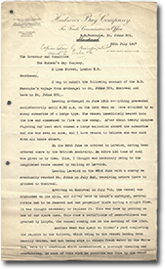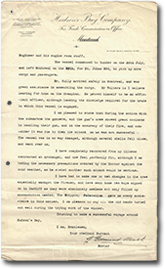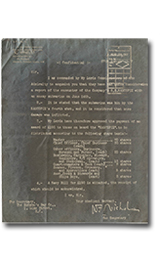The 100th anniversary of the First World War is now finished but the records will continue to be preserved at the Archives and accessible to current and future generations who want to know more about the time period. In addition, this blog will remain on our website as an additional resource.
July 2017 Posts:
- 31 July: “Doing your duty as a free man”
- 24 July: “On Active Service”: Herb Francis – follow-up #2
- 17 July: Exploring London While On Leave
- 10 July: Enemy fire: The Nascopie encounters a German submarine
- 4 July: Celebrating Canada's 50th birthday in France 100 years ago
31 July 2017
“Doing your duty as a free man”
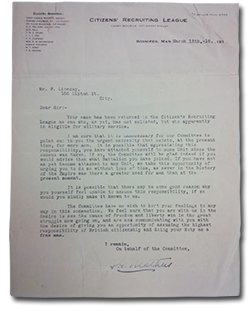
enlarge
After much controversy and debate, conscription was enacted in Canada in August 1917. Before that some governments, individuals and groups actively encouraged men to enlist voluntarily. The Citizens’ Recruiting League, headed by several prominent Winnipeggers including Chief Justice Thomas Mathers, was one such organization.
Fred Livesay of 166 Lipton Street received a letter from the Citizens Recruiting League in March 1916. The letter indicated that Livesay had been identified as a man eligible for military service, and inquired as to why he had not yet enlisted.
The letter concluded:
“The Committee have no wish to hurt your feelings in any way in this connection. We feel sure that you are with us in the desire to see the cause of freedom and liberty win in the great struggle now going on, and are now communicating with you with the desire of giving you an opportunity of assuming the highest responsibility of British citizenship and doing your duty as a free man.”
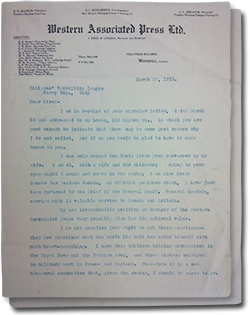
enlarge (2 images)
A 41-year-old husband and father of two, Livesay responded that he was ineligible to serve in the ranks due to poor eyesight, and had not been offered a commission. Furthermore, he suggested that he was serving his country through his work as press censor for Western Canada and manager of the Western Associated Press.
However, Livesay wrote:
“I do not question your right to ask these questions –– they are question each man worth his salt has asked himself with much heart-searching. I have four br[o]thers holding commission in the Royal Navy and the British Army, and three sisters employed in military work in France and England. Therefore, it is a not unnatural assumption that, given the chance, I should be eager to go.”
Livesay went on to serve as a war correspondent with the Canadian Corps on the Western Front in 1918 until the end of the First World War and wrote of his experiences in his book "Canada's Hundred Days: with the Canadian Corps from Amiens to Mons, August 8 – November 11, 1918."
Search Tip: Search “J. F. B. Livesay” in Keystone for more information.
Feedback (0)
E-mail us at archiveswebmaster@gov.mb.ca with a comment about this blog post. Your comments may be included on this page.
24 July 2017
“On Active Service”: Herb Francis – follow-up #2
As noted in our 1 May 2017 blog post, when we created our 2015 hallway display, “On Active Service”, we looked for photographs in our holdings of each of the soldiers whose letters we were displaying. We were not able to locate photographs of two of the soldiers: Frank Leathers and Herbert Francis.
In the last few months we have located photographs of both of the men from within our holdings and have been really excited to see what these correspondents looked like! The earlier blog post was about Frank Leathers and this one is about Herb Francis.
We recently acquired the records of Colin Black, another Manitoban who served in the First World War. The archivist working on these records found that there was a photograph of Colin Black in the Lord Selkirk Association of Rupert’s Land photograph album. Colin Black was the grandson of Rev. John Black, an early Red River settler.
Another archivist recalled that Herb Francis was also a grandson of Rev. Black and when it was discovered that the photograph was of some of the grandsons of Rev. Black serving in the First World War, we found that the photograph pictured Herb Francis, and his brother Charles whose records are also in the Archives’ holdings!

enlarge
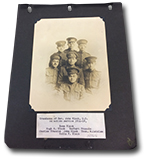
enlarge full size
Photo 1. Grandsons of Rev. John Black - on active service 1914-1918:
Ross Black, Hugh A. Black, Herbert Francis, Charles Francis, John Black, Thomas W. Laidlaw, Colin F. Black, [ca. 1916], P7912.
We displayed the Lord Selkirk Association album at our recent open house to commemorate the 100th anniversary of the Battle of Vimy Ridge, alongside some of Herb and Charles’ letters and other records. It was wonderful for visitors to be able to see the men who wrote the letters and to make more connections between the people and the records in our holdings!
Search Tip: Search “Lord Selkirk Association” in Keystone to find out more about the photograph album and “Sarah Margaret Francis” to find out more about Herb and Charles Francis and their First World War correspondence.
Feedback (0)
E-mail us at archiveswebmaster@gov.mb.ca with a comment about this blog post. Your comments may be included on this page.
17 July 2017
Exploring London While On Leave
Colin Francis Black was born in Carman, Manitoba in 1896. He was a student at the University of Manitoba and a member of the Canadian Officer's Training Corps (COTC) when he enlisted as a private in the 196th Battalion in 1916. Black sailed to England in November 1916 on the S. S. Southland and was stationed at Seaford Camp.
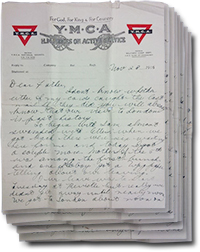
enlarge (8 images)
Colin Black correspondence 1916, P7733/1.
On November 28, 1916 Colin Black wrote to his father about his adventures while on leave in London.
“We got in a taxi and went to the Maple Leaf Club which is run exclusively for Canadian Soldiers by London Society. They charge 1s 4d for bed and breakfast and a real place at that. Princess Pat waiting on one of the tables one day but we didn’t know it until after we were done.”
Black and his friends went to theatre shows and restaurants where he noted differences between London and Manitoba society:
“Things here aren’t any more expensive than any ordinary hotel but they put up in grand style. One thing strange here all the ladies smoke in the theatres and restaurants.”
They also visited the sights of London including Madame Tussaud’s:
“We went to the wax works too. These are world famous for their naturalness. We saw all the worlds past & present celebrities including Miss Cavell. One thing funny happened there. One of the boys stood up in a corner resting on his cane and attracted the admiration of a few girls that were passing when they got close he gave a yell and they nearly died with fright.”
Colin Black served in France with the Canadian Mounted Rifles from March to August 1917. He was hospitalized with diphtheria in August 1917 in France and was then transferred to hospital in England. Black did not fully recover and was discharged from the army in March 1918.
See our 24 July 2017 blog post to learn more about the Black family and to see a photograph of Colin Black and other family members who served in the First World War.
Search Tip: Search “Colin Black” in Keystone for more information.
Feedback (0)
E-mail us at archiveswebmaster@gov.mb.ca with a comment about this blog post. Your comments may be included on this page.
10 July 2017
Enemy fire: The Nascopie encounters a German submarine
The Hudson’s Bay Company is not known for its wartime heroics during the First World War. Yet one story involving the ice-breaker Nascopie placed the company in the midst of battle theatre. It involves the exchange of gunfire with a German submarine.
Captain Edmund Mack reported on the incident to the Governor and Committee in London on 30 July 1917:
“Leaving Archangel on June 12th everything proceeded satisfactorily until 2.30 pm, on the 14th when we were attacked by an enemy submarine of a large type. The vessel immediately headed into the ice and commenced to fire on the enemy. After about twenty minutes fighting our last shot caused a large explosion aboard the submarine and she was seen no more, and I have reason to believe she was sunk with all hands aboard.”
Transcription of letter from Captain Mack to the Governor and Committee of the Hudson’s Bay Company. Hudson's Bay Company Archives, Archives of Manitoba, Governor and Committee general inward correspondence, 1911-1923, HBCA A.10/189a.
All correspondence to be addressed The Fur Trade Commissioner, Hudson’s Bay Company, Montreal
Cable address “Beaver” Montreal
Hudson’s Bay Company, Fur Trade Commissioner’s Office
S.S. Nascopie, St, Johns Nfd,
30th July 1917
In your reply refer to No ____.
The Governor and Committee, The Hudson’s Bay Company, 1 Lime Street, London, E.C.
Gentlemen,
I beg to submit the following account of the S.S. Nascopie’s voyage from Archangel to St, Johns Nfld, Montreal and back to St, Johns Nfd,.
Leaving Archangel on June 12th everything proceeded satisfactorily until 2.30 pm, on the 14th when we were attacked by an enemy submarine of a large type. The vessel immediately headed into the ice and commenced to fire on the enemy. After about twenty minutes fighting our last shot caused a large explosion aboard the submarine and she was seen no more, and I have reason to believe she was sunk with all hands aboard.
On the 29th June we arrived in Lerwick, having been ordered there by the British Admiralty. An extra 100 tons of coal was given us by them, this I thought was necessary owing to the lengthened route caused by calling at Lerwick.
Leaving Lerwick on the 23rd June with a convoy we eventually reached St. Johns on July 2nd, receiving orders there to proceed to Montreal.
Arriving at Montreal on July 7th, the vessel was drydocked on the 11th, and survey held by Lloyd's surveyor, several rivets had to be renewed and one propellor blade having a slight flaw, it was thought necessary to replace it. This was done by putting on one of our spare ones. This done a certificate of seaworthiness was granted by Lloyds, the vessel coming out on the morning of the 13th.
Another week was spent at Vicker’s yard completing the repairs to the boilers, which owing to the vessel having been heavily driven, and not being able to obtain fresh water in the White Sea, were in a condition which necessitated a thorough cleaning and overhauling. As much as possible was done by the Chief
-2-
Engineer and his engine room staff.
The vessel commenced to bunker on the 20th July, and left Montreal on the 26th, for St. Johns Nfd, to pick up more cargo and passengers.
Mr, Mully arrived safely in Montreal, and was great assistance in assembling the cargo. Mr Walters is I believe leaving for home on the Grampian. He proved himself to be an efficient officer, although lacking the knowledge required for the trade in which this vessel is engaged.
I am pleased to state that during the action with the submarine the gunners, and the gun’s crew showed great coolness in handling their gun, and in the accuracy of their fire, and consider it was due to them the attack on us was not successful. The vessel was in no way damaged, although several shells fell close, and went over us.
I have completely recovered from my illness contracted at Archangel, and now feel perfectly fit, although I am taking the necessary precautions ordered by the Doctor against the cold weather, as he stated another such attack would be serious.
I have had to make one or two changes in the crew especially amongst the firemen, and have sent home two boys signed in Cardiff as they were absolutely useless and only filled up accommodation needed. The Shipping Federation gave me every assistance in this matter. I am pleased to say all the old hands turned out well during the trying work of the winter.
Trusting to make a successful voyage around Hudson’s Bay,
I am, Gentlemen, Your obedient Servant [signed G. Edmund Mack] Master
Transcription of Letter from the Secretary of the Hudson’s Bay Company to Captain Mack. Hudson's Bay Company Archives, Archives of Manitoba, Governor and Committee general inward correspondence, 1911-1923, HBCA A.10/189a.
L.P. – No. 8.
In any further communication on the subject, please quote M. 68845/17 and address letter to – The Secretary, Admiralty, Whitehall, London, S. W.
-: Confidential :-
27th August 1917
Sir,
I am commanded by My Lords Commissioners of the Admiralty to acquaint you that they have had under consideration a report of the encounter of the Company’s S.S.Nascopie with an enemy submarine on June 14th.
2.- It is stated that the submarine was hit by the Nascopie’s fourth shot, and it is considered that some damage was inflicted.
3. – My Lords have therefore approved the payment of an award of £150 to those on board the “Nascopie,” to be distributed according to the following share basis:
- Master: 80 shares
- Chief Officer, Chief Engineer: 30 shares (each)
- Other officers, Engineers, Surgeon and Purser: 20 shares (each)
- Boatswain, Carpenter, Steward, Gunlayers, W/T operators, and Donkeyman: 12 shares (each)
- Quartermasters & Cook: 8 shares (each)
- Seamen, Firemen, Greasers and Apprentices: 5 shares (each)
- Asst. Cooks & Stewards and Ships Boys: 3 shares (each)
4.- A Navy Bill for £150 is attached, the receipt of which should be acknowledged.
I am, Sir, Your obedient Servant, [signed W.F. Nicholson] for Secretary.
The Secretary, The Hudson’s Bay Co., 1, Lime Street, E.C.
Hudson's Bay Company Archives, Archives of Manitoba,
Governor and Committee general inward correspondence, 1911-1923,
HBCA A.10/189a.
In his letter, he praises his crew for their tenacity under pressure. In turn, the British Admiralty wrote to the Governor and Committee, informing them that they awarded the Nascopie’s crew £150 to be divided among them.
While it was later determined that the submarine had not been sunk, the incident remains a vivid tale of the HBC’s involvement in First World War.
For more stories about the Nascopie, see our previous blog posts from 12 Jan 2015, 9 Feb 2015, 2 March 2015 and 15 June 2015.
Search Tip: Search “Nascopie” in Keystone for more information on records about the Nascopie.
Feedback (0)
E-mail us at archiveswebmaster@gov.mb.ca with a comment about this blog post. Your comments may be included on this page.
4 July 2017
Celebrating Canada's 50th birthday in France 100 years ago
The Archives of Manitoba recently acquired the diary of Wilfred Conway Rutherford, a First World War soldier from La Rivière, Manitoba. He enlisted in March 1916 with the 184th Overseas Battalion and was sent to France in February of the following year.
Rutherford wrote regular, detailed entries describing his daily activities, thoughts and feelings.
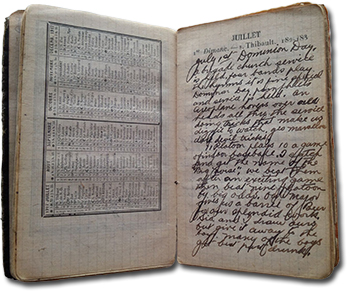
enlarge image
Archives of Manitoba,
Wilfred Rutherford diary, 1917
P7913/6
In June, 1917, Rutherford and his unit were behind the lines for a rest and in his diary entry of Saturday 30 June 1917, Rutherford writes:
“When I think of tomorrow being the 1st of July I feel lonely and Sunday [too] adds to my lonely [thoughts]. A year ago I was much nearer home.”
The following day he outlines the soldiers’ activities in honour of Dominion Day, now known as Canada Day.
“July 1st Dominion Day. A brigade church service is held. Four bands play the hymns it is fine. Special Dominion Day pamphlets and service is held. An aeroplane hovers over our heads all through the service doing tricks that make us dazzle to watch. Yes marvellous dare devil tricks.
“11 Platoon plays 10 [Platoon] a game of indoor baseball. I catch and get the name of the “Big Noise” we beat them after an exciting game then beat nine platoon by big odds. Our major gives us a barrel of Beer for our splendid work. Sia and I draw ours but give it away to the boys. Many of the boys get best part drunk.”
The following day Rutherford’s unit broke camp and was on the move back up to the front line. Rutherford was wounded in the foot on July 23rd.
Wilfred Rutherford’s diary will soon be described in Keystone and available for consultation in the Archives Research Room.
Feedback (0)
E-mail us at archiveswebmaster@gov.mb.ca with a comment about this blog post. Your comments may be included on this page.




